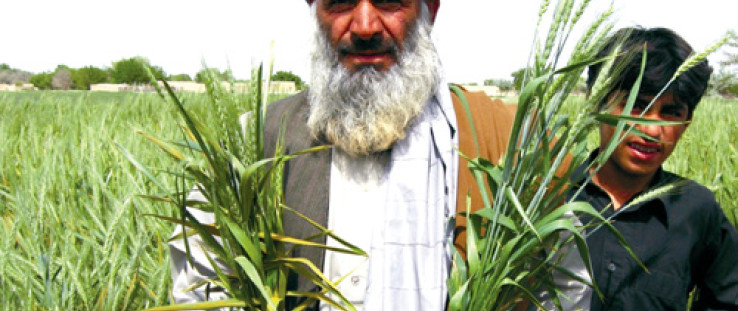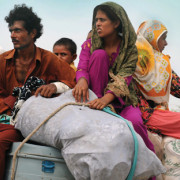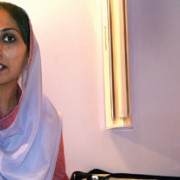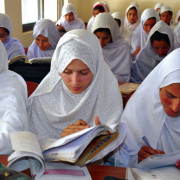 A farmer in Balochistan, Pakistan, displays wheat affected by wheat stem rust. USAID is working to develop agriculture in Balochistan and prevent the damage caused by the rust.
USAID
A farmer in Balochistan, Pakistan, displays wheat affected by wheat stem rust. USAID is working to develop agriculture in Balochistan and prevent the damage caused by the rust.
USAID
 A farmer in Balochistan, Pakistan, displays wheat affected by wheat stem rust. USAID is working to develop agriculture in Balochistan and prevent the damage caused by the rust.
USAID
A farmer in Balochistan, Pakistan, displays wheat affected by wheat stem rust. USAID is working to develop agriculture in Balochistan and prevent the damage caused by the rust.
USAID
February
More than 32 million Pakistani children under the age of 5 are immunized against polio during February's National Immunization Days. Since 2003, USAID has contributed $1 million per year to both the World Health Organization (WHO) and UNICEF to fund their participation in National Immunization Days. The WHO supports and monitors the polio campaigns and maintains a surveillance system to detect cases of polio; UNICEF conducts outreach and communications related to the campaigns.
FACT BOX
- Population: 184,404,791 (July 2010 est.)
- Percentage of people living below poverty line: 24% (FY 2005/2006 est.)
Main development challenges:
- Decades of internal political disputes and low levels of foreign investment
- Severe electricity shortfalls
- Inflation (14.2% in 2009)
- Expanding investment in education, health care, and electricity pro-duction, and reducing dependence on foreign donors
(Source: CIA World Factbook)
Main assistance sectors:
- Agriculture, democracy and governance, economic growth, education, energy, infrastructure, health, and humanitarian assistance
- Year USAID began its program: 1951
(Source: USAID)
March
Administrator Rajiv Shah meets with Pakistan government officials on the best role for USAID and development during a Pakistan development roundtable. At the event, Shah and Shahid Rafi, secretary of Pakistan's Ministry of Water and Power, sign implementation letters confirming joint efforts to upgrade three Pakistani thermal power stations in Guddu, Jamshoro, and Muzaffargarh. Refurbishing the power stations will increase power to Pakistan by 315 megawatts, enough to power nearly 400,000 homes. The event is part of the first U.S.-Pakistan Strategic Dialogue, co-chaired by Secretary of State Hillary Rodham Clinton and Foreign Minister Makhdoom Shah Mahmood Qureshi, to engage high-level participation between the two governments.
April
During his first official visit to Pakistan from April 11 to 15, Shah emphasizes "a commitment that USAID, and on behalf of our entire portfolio of foreign assistance here, that we would do things differently going forward in order to be better partners, deeper partners, and more respectful partners of the government of Pakistan and the people of Pakistan and Pakistani institutions." Among the trip's highlights are a meeting with Pakistani President Asif Ali Zardari, and a press conference that draws more than 80 Pakistani and international media outlets.
Late July
U.S. Ambassador to Pakistan Anne W. Patterson issues a disaster declaration in response to extraordinarily heavy rainfall and flooding that begins in northern Pakistan in late July. The flooding drifts south to Sindh province, affecting an estimated 18 million people in every province. More than 75 percent of affected families are located in Sindh and Punjab provinces, and 1.7 million homes are destroyed. Widespread flooding is reported in 82 of Pakistan's 122 districts.
In coordination with the Pakistan government and other relief agencies, USAID responds quickly to the devastation wrought by the floods. USAID's Office of U.S. Foreign Disaster Assistance (OFDA) immediately sends water treatment units and Zodiac boats to help rescue stranded people. A Disaster Assistance Response Team (DART) soon arrives to assess conditions, transport relief supplies, and help meet the immediate needs of millions of people affected by the floods in Pakistan.
August
Shah visits flood-ravaged Pakistan to assess the situation on the ground and determine the next steps for USAID. The first high-level U.S. government official to visit Pakistan, he travels on a C-130 airplane packed with plastic sheeting and other humanitarian commodities from OFDA, observes the USAID-supported World Food Program distributing meals, meets with donors, and consoles flood victims, including women and children who tell Shah that they have "lost everything."
September
The U.S. government signs an agreement with the government of Pakistan to begin using the first tranche of funds under the Kerry-Lugar-Berman Act, which pledged a $7.5 billion, five-year assistance package for Pakistan. The agreement also launches USAID's new business model to increase the role of local organizations in carrying out U.S. assistance programs. Over the lifespan of the Act, USAID expects to increase the share of programs implemented by local organizations to approximately 70 percent.
October
October marks the 5th anniversary of a devastating 7.6 magnitude earthquake that struck Pakistan's Azad Jammu and Kashmir region in 2005. USAID's Earthquake Reconstruction Program has been critical in helping the region recover. The program helped "build back better" by constructing modern buildings that are earthquake-resistant, trained thousands of health and education specialists to deliver quality services for 2.2 million residents, and rallied the communities to participate in the management of their local facilities. USAID rebuilt 21 schools and 15 health-care facilities that provide basic health care to approximately 200,000 people in Bagh District. The program also created employment, helped businesses access microfinance, re-established markets, and expanded trade opportunities, thereby increasing the per capita income in the earthquake-affected areas by 81 percent.
November
Three months after the flooding, USAID and the U.S. government have delivered more than $579 million in emergency relief to the flood-affected communities. Assistance includes materials for shelter, food, medical care, potable water, rescue operations, and basic commodities. As the flood waters begin to recede and communities start returning to their areas, USAID focuses on restoring livelihoods. Flood-affected people receive seeds and fertilizer for the planting season, cattle, cash for work, and a variety of other assistance to restore jobs, businesses, key services, and homes. USAID's DART team stands down as flood-related assistance shifts from emergency relief to longer-term recovery and reconstruction efforts. USAID's country office focuses its work on re-establishing Pakistan's agriculture, infrastructure, energy, and economic development.
December
Andrew Sisson is sworn in as USAID's new Pakistan mission director to lead the Agency's programs in the country and the piloting of new business models around the world.
USAID completes its six-year maternal and child health program that reduced neonatal mortality in Pakistan by 23 percent. The $93 million Pakistan Initiative for Mothers and Children (PAIMAN) improved the health of more than 5.7 million Pakistani women and children from 2004 to 2010. The program trained more than 18,000 health specialists and upgraded 103 health facilities as well as 57 training facilities.











Comment
Make a general inquiry or suggest an improvement.